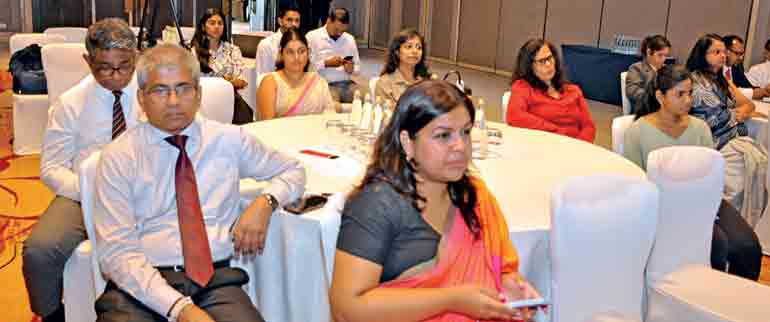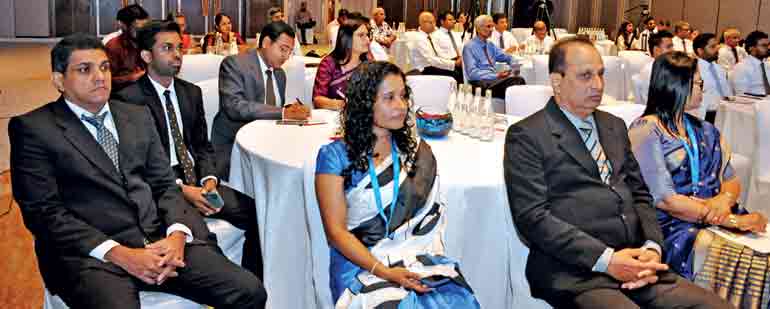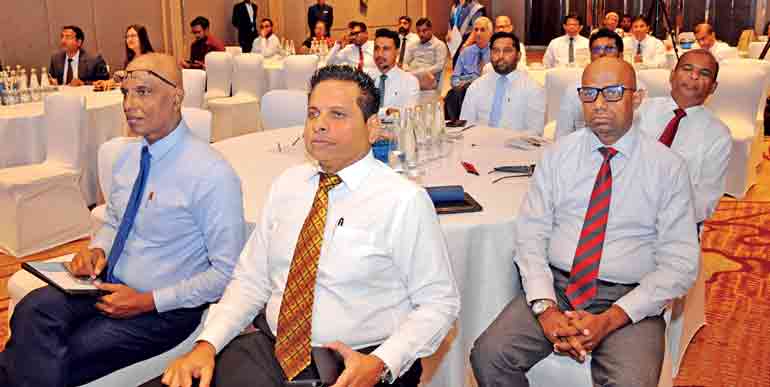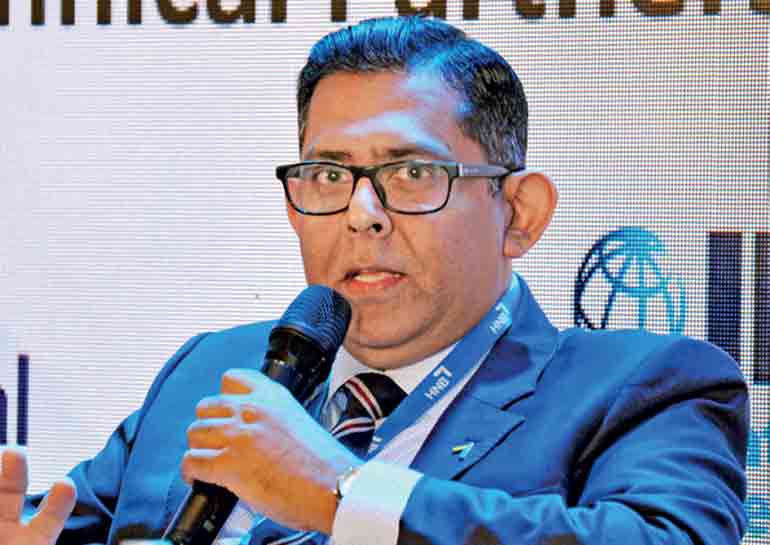Thursday Nov 06, 2025
Thursday Nov 06, 2025
Tuesday, 4 November 2025 00:25 - - {{hitsCtrl.values.hits}}
 |
 |
 |
 |
 |
 |
| CBSL Governor Dr. Nandalal Weerasinghe | STRA Chairman and CBSL Assistant Governor Dr. Chaamindra Bandara | IFC South Asia Financial Institutions Group Manager Mehdi Cherkaoui | CRIB General Manager Pushpike Jayasundara | Legal Drafting Committee Member Thushantha Wijemanne | Creditinfo Business Development Manager Joe Bowerbank |
Central Bank of Sri Lanka and the Credit Information Bureau (CRIB) yesterday launched the Secured Transactions Register (STR), introducing a new legal and digital framework that allows movable assets to be used as collateral for loans, especially for micro, small and medium enterprises (MSMEs).
The event, held at the Shangri-La Hotel in Colombo, also marked the official commencement of operations of the Secured Transactions Registration Authority (STRA), established under the Secured Transactions Act No. 17 of 2024.
The International Finance Corporation (IFC), a member of the World Bank Group, provided technical assistance and the European Union’s regional initiative ‘Accelerating Climate Smart and Inclusive Infrastructure in South Asia’ (ACSIIS) provided the funding.
CBSL Governor Dr. Nandalal Weerasinghe, the Chief Guest at the event, said the initiative is a vital step in improving access to finance for MSMEs, which often lack traditional collateral such as land or buildings.
“Movable assets such as machinery, equipment, vehicles, and receivables represent almost 78% of business capital in developing economies, yet remain underutilised in Sri Lanka,” he said.

“This register creates a transparent market for lenders to recognise the value of these assets and provides confidence for banks to lend to smaller businesses,” he added.
Dr. Weerasinghe described the reform as part of the broader effort to modernise Sri Lanka’s financial system and strengthen inclusion.
He credited the Finance Ministry and the World Bank’s International Finance Corporation (IFC) for their role in shaping the reform and establishing the STRA. “This is not just a technical change,” he said. “It is a structural reform that supports financial inclusion, innovation, and the growth of productive enterprises.”
STRA Chairman and Central Bank Assistant Governor Chaamindra Bandara said the register addresses a long-standing weakness in the country’s credit infrastructure.
“MSMEs make up nearly 80% of all enterprises and contribute around half of GDP, but their access to finance has been limited by their inability to pledge fixed assets,” he said.
“The new system closes that gap by allowing banks to accept movable property, including machinery, crops, livestock, receivables, and even intellectual property, as valid collateral.”
He explained that the Credit Information Bureau (CRIB) will operate the electronic register, enabling lenders to check existing encumbrances and register their own interests.
“This reform will eliminate double collateralisation, improve transparency, and significantly reduce transaction costs,” Bandara said. He added that it will also open doors for knowledge-based industries to use intangible assets such as patents and copyrights to access finance.
IFC South Asia Financial Institutions Group Manager Mehdi Cherkaoui said the reform reflects global best practice and is aligned with Sri Lanka’s National Financial Inclusion Strategy, which IFC helped design.
“Strengthening the legal framework for secured lending is a critical step to help small businesses grow,” he said. “With an effective system, the financial sector can extend innovative financing to a wider range of borrowers, including women entrepreneurs.”

Cherkaoui said similar IFC-supported reforms in other countries have generated significant results. “In Ghana, a secured transactions framework facilitated about 14 billion dollars in financing for over 8,000 SMEs and 30,000 microenterprises,” he said. “In China, between 2004 and 2020, IFC-supported reforms unlocked an estimated 28 trillion dollars in financing for more than 4 million SMEs.”
IFC will continue working with the Central Bank and STRA under the EU-supported Accelerating Climate-Smart and Inclusive Infrastructure in South Asia program to promote financial literacy and raise awareness about the new system.
CRIB General Manager Pushpike Jayasundara said the register represents a complete new dimension to credit in Sri Lanka. “When you say credit, it has always been associated with collateral, usually land and buildings,” he said. “Now, banks can lend against movable assets like inventories or machinery within a legally valid framework.”
He said CRIB’s 30 years of experience in data management, including its 20 million-record database, positions it to manage the registry effectively. “It will serve as a public notice board where lenders and borrowers can verify security interests and ensure that collateral information is properly recorded,” he said.
Legal Drafting Committee Member Thushantha Wijemanne said the Act was designed to ensure consistency and continuity. “We needed to harmonise multiple laws so that the system operates smoothly within Sri Lanka’s dual legal framework,” he said.
The law also defines how security rights apply when the nature or ownership of movable assets changes. “We wanted to ensure that a security interest carries forward even if the asset itself evolves,” he said. The Act introduces a clear priority system among creditors and mandates registration of all security interests with the STRA, closing gaps that once allowed the same asset to be pledged to multiple lenders.

Creditinfo Business Development Manager Joe Bowerbank said Sri Lanka’s new system mirrors the success of Kenya’s 2017 reform, which transformed movable-asset lending and boosted SME finance.
“Kenya faced many of the same issues Sri Lanka has today, fragmented laws, manual systems, and repeated pledging of the same assets,” he said. “After the reforms, transparency improved, fraud fell, and lending increased.” Within four years, over 600,000 movable assets were registered, helping banks issue larger loans with greater confidence.
Bowerbank said similar benefits can accrue to Sri Lanka if adoption grows.
“We need the data in the database to drive value,” he said. “The more digital records we can centralise, mobile registries, company data, and credit histories, the more valuable this system will be.”
He noted that such systems also promote inclusion by enabling women and smaller enterprises, who may lack land titles, to use movable property to access finance. “Centralising collateral and business data empowers lenders and protects borrowers,” he said. “It builds trust, expands opportunity, and drives inclusion.”
Pix by Lasantha Kumara
 |
| Hatton National Bank CEO Damith Pallewatte |
Hatton National Bank CEO Damith Pallewatte said the launch of the Secured Transactions Register (STR) marks a long-overdue step toward improving risk visibility and credit access for small and medium enterprises (SMEs), but stressed that the adjustment in lending practices and risk premiums will take time.
Speaking at the Colombo event, Pallewatte said the absence of a unified mechanism to record movable-asset pledges had long undermined confidence in collateral-based lending.
“We have seen instances where the same movable asset was mortgaged to three banks at the same time,” he said. “Now we have visibility, legal clarity, and defined priority among lenders—something the sector has needed for years.”
He said the reform introduces a different perspective to risk assessment and will gradually shift banks from property-based lending toward models centred on cash flow, inventory turnover, and receivables.
“The registry allows us to view movable property as a risk mitigator,” Pallewatte explained. “We can now rely on these assets with more certainty when lending to higher-risk sectors, because we can recover in case of default.”
However, he warned that the evolution of risk pricing will be gradual.
“Even though we spoke of premiums, in actual market operations, these premiums are not yet structured or consistent,” he said. “So we can’t expect lending costs to adjust immediately. Both borrowers and lenders must build experience and confidence before premiums compress.”
Pallewatte said the registry provides a robust mechanism for banks to secure their interests, but confidence in movable collateral will develop over time.
“People will have to see that movable assets, machinery, inventories, even intellectual property, can be relied upon,” he said. “It will take time for these assets to become embedded in our risk-assessment systems.”
He cautioned that while the registry strengthens the lender’s ability to recover assets, it does not automatically ensure borrower discipline.
“When you mortgage family property, that’s the last thing you want to let go,” he said. “But when you pledge a movable asset, your willingness to pay can drop. The system must balance ability and willingness to pay.”
Pallewatte said maintaining this balance is the secret to success.
“If we expect lending to surge and bad loans to fall just because we have a registry, that’s not realistic,” he said. “We must navigate a transition period carefully, ensuring businesses understand why this mechanism exists, to enable, not to burden, their growth.”
He noted that HNB already lends heavily to higher-risk sectors, including cottage industries.
“We have over Rs. 50 billion lent to grassroots businesses, and our default rate is below the industry average,” he said. “That proves cash-flow-based lending works. With the registry, other institutions can now follow that model with greater confidence.”
Calling the reform “a fantastic and timely initiative,” Pallewatte said it is a turning point for the banking sector but one that requires patience, prudence, and education.
“This isn’t an overnight change,” he said. “It’s a new way of thinking about credit, and it will take commitment from both sides to make it work.”